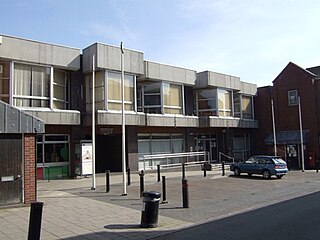
Bangor Castle is a country house situated in Castle Park in Bangor, County Down, Northern Ireland. The building, which is also referred to as Bangor Town Hall and is now used as the offices of Ards and North Down Borough Council, is a Grade A listed building.

Dundee House is a municipal building in North Lindsay Street in Dundee, Scotland. The original part of the structure, which currently serves as the administrative headquarters of Dundee City Council, is Category B listed.

St. Mary's Church, Presbytery and Convent are in Back Lane, Little Crosby, Sefton, Merseyside, England. The church is an active Roman Catholic parish church in the diocese of Liverpool which was built in 1845–47. The presbytery and convent were both built in the 18th century, and altered in the 19th century. The convent originated as a chapel, and has since been converted into a private dwelling. Both the church and the former convent with its attached presbytery are recorded in the National Heritage List for England as designated Grade II listed buildings.

Redesdale Hall, also referred to as Moreton-in-Marsh Town Hall, is a municipal building in the High Street, Moreton-in-Marsh, Gloucestershire, England. The building, which is used as an events venue, is a Grade II listed building.

New Cumnock Town Hall is a municipal building in Castle, New Cumnock, East Ayrshire, Scotland. The structure, which is used as a community events venue, is a Category C listed building.

Anstruther Town Hall is a municipal building in School Green, Anstruther Easter, Fife, Scotland. The structure, which is used as a community events venue, is a Category B listed building.

Denny Town House is a municipal building in Glasgow Road, Denny, Falkirk, Scotland. The structure is used by Falkirk Council for the provision of local services.

Falkland Town Hall is a municipal building in the High Street, Falkland, Fife, Scotland. The structure, which has been converted for use as offices and as shops, is a Category A listed building.

Kinghorn Town Hall is a municipal building in St Leonard's Place, Kinghorn, Fife, Scotland. The structure, which is used as holiday accommodation for tourists, is a Category B listed building.

Boston Sessions House is a judicial structure in Church Close, Boston, Lincolnshire, England. The structure, which used to be the main courthouse for the north of Parts of Holland, is a Grade II* listed building.

Kirkwall Town Hall is a municipal building in Broad Street, Kirkwall, Orkney, Scotland. The structure, which is currently used as a community events venue, is a Category B listed building.

County Buildings is a municipal structure in Newtown Street, Duns, Scottish Borders, Scotland. The complex, which was the headquarters of Berwickshire County Council and was also used as a courthouse, is a Category C listed building.

Pembroke Town Hall is a municipal building in Merrion Road, Ballsbridge, Dublin, Ireland. The building currently accommodates the offices of the City of Dublin Vocational Education Committee.

Bakewell Town Hall is a municipal building in Anchor Street in Bakewell, a town in Derbyshire in England. The building, which serves a community events venue, is also the home of Bakewell Town Council.

Dalton Town Hall is a municipal building in Station Road, Dalton-in-Furness, a town in Cumbria, England. The building, which accommodates the offices and meeting place of Dalton-in-Furness Town Council, is a Grade II listed building.
Failsworth Town Hall, also known as Failsworth and Hollinwood District Town Hall, is a former municipal building on Oldham Road, Failsworth, a town in Greater Manchester in England. The building, which served as the offices and meeting place of Failsworth Urban District Council, now accommodates a library, a lifelong learning centre, the current council's support and housing team, and some charities.
Osborne House, formerly Cheadle Town Hall, is a former municipal building in Leek Road in Cheadle, Staffordshire, a town in England. The building retains the façade of the former town hall but has been extensively redeveloped for residential use behind the façade.

Whitchurch Civic Centre is a municipal building in Whitchurch, a town in Shropshire, in England. It accommodated the offices of Whitchurch Town Council until September 2023, when the building was closed, following the discovery of potentially dangerous reinforced autoclaved aerated concrete.

The Council House is a former municipal building in Soho Road in Handsworth, West Midlands, a suburb of Birmingham in England. The building, which is currently used as a public library and college campus, is a Grade II listed building.

Thurrock Town Hall is a newest part of municipal complex in New Road in Grays, Essex, a town in England. The complex accommodates the offices and meeting place of Thurrock Council.



















